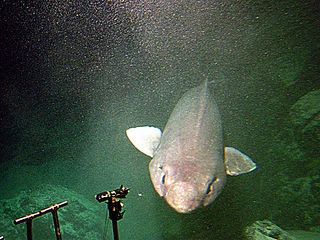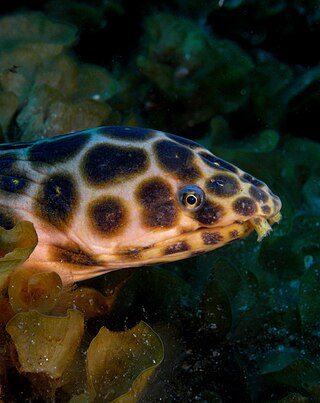
The Anguillidae are a family of ray-finned fish that contains the freshwater eels. All the extant species and six subspecies in this family are in the genus Anguilla, and are elongated fish of snake-like bodies, with long dorsal, caudal and anal fins forming a continuous fringe. They are catadromous, spending their adult lives in freshwater, but migrating to the ocean to spawn.

The false catshark or sofa shark is a species of ground shark in the family Pseudotriakidae, and the sole member of its genus. It has a worldwide distribution, and has most commonly been recorded close to the bottom over continental and insular slopes, at depths of 500–1,400 m (1,600–4,600 ft). Reaching 3.0 m (9.8 ft) in length, this heavy-bodied shark can be readily identified by its elongated, keel-like first dorsal fin. It has long, narrow eyes and a large mouth filled with numerous tiny teeth. It is usually dark brown in color, though a few are light gray.

The Canary moray is a moray eel of the family Muraenidae, found only around the Canary Islands (Spain) in the northern Atlantic, at depths between 17 and 605 m. Its length is up to 35 cm (14 in).
The marine life found in the Canary Islands is interesting, being a combination of North Atlantic, Mediterranean, and endemic species. In recent years, the increasing popularity of both scuba diving and underwater photography have provided biologists with much new information on the marine life of the islands.

The Mediterranean moray, also known as Roman eel, is a species of fish in the moray eel family. It has a long eel-like body and is found in the eastern Atlantic Ocean and Mediterranean Sea. Its bite can be dangerous to humans.
Nettenchelys bellottii is a species of duckbill eel in the family Nettastomatidae. It is found in the western Indian Ocean and the Red Sea. This species is only known from larvae.

Nettenchelys is a genus of eels in the duckbill eel family Nettastomatidae.

The brown garden eel, also known simply as the garden eel, is an eel in the family Congridae. It was described by Albert Günther in 1870. It is a tropical, marine eel which is known from the eastern and western Atlantic Ocean, including Madeira, the Canary Islands, Senegal, the Bahamas, the Florida Keys, the Caribbean, Mexico, Belize, Honduras, and Brazil. It dwells at a depth of 10–60 m, most commonly between 20 and 60 m, and leads a nonmigratory, benthic lifestyle, inhabiting reefs in colonies. They likely spawn during the warm season. The larval state of development lasts for about 6–8 months. Adult males can reach a maximum total length of 51 centimetres.
The solitary duckbill eel is an eel in the family Nettastomatidae. It was described by Peter H. J. Castle and David G. Smith in 1981. It is a marine, deep-water-dwelling eel which is known from the Indo-Western Pacific, including Kyushu–Palau Ridge, the Philippines, Australia, and the Hawaiian Islands. It is known to dwell at a depth range of 415 to 610 metres. Males can reach a maximum total length of 46.5 centimetres (18.3 in).
Nettenchelys erroriensis is an eel in the family Nettastomatidae. It was described by Emma Stanislavovna Karmovskaya in 1994. It is a marine, deep water-dwelling eel which is known from Error Seamount, in the western Indian Ocean. It dwells at a depth range of 395 to 420 metres. Females can reach a maximum total length of 33.5 centimetres (13.2 in).
Nettenchelys exoria is an eel in the family Nettastomatidae. It was described by James Erwin Böhlke and David G. Smith in 1981. It is a marine, deep water-dwelling eel which is known from the western central Atlantic Ocean, including Florida, USA and the Bahamas. It dwells at a depth range of 277 to 494 meters. Males can reach a maximum total length of 46.7 centimeters (18.4 in).
The bridge duckbill eel is an eel in the family Nettastomatidae. It was described by Peter Henry John Castle and David G. Smith in 1981. It is a marine, deep water-dwelling eel which is known from the western Pacific Ocean, including New Caledonia, the Philippines, and Indonesia. It dwells at a depth range of 400–412 metres (1,312–1,352 ft). Females can reach a maximum total length of 43.1 centimetres (17.0 in).
Nettenchelys inion is an eel in the family Nettastomatidae. It was described by David G. Smith and James Erwin Böhlke in 1981. It is a marine, deep water-dwelling eel which is known from a single specimen discovered near North Bimini Marine Protected Area in 1964. It is known to dwell at a depth range of 458 to 531 meters. Males can reach a total length of 42.3 centimeters (16.7 in).
Nettenchelys paxtoni is an eel in the family Nettastomatidae. It was described by Emma Stanislavovna Karmovskaya in 1999. It is a marine, tropical eel which is known from Vanuatu, in the western Pacific Ocean. The only known specimen had a total length of 24.8 centimetres (9.8 in), and was recovered from the stomach contents of a sea snake.
The pygmy pikeconger or pygmy duckbill eel, is an eel in the family Nettastomatidae. It was described by David G. Smith and James Erwin Böhlke in 1981. It is a marine, tropical eel which is known from the western central Atlantic Ocean, including Venezuela and the Gulf of Mexico, and possibly more locations. It is known to dwell at a depth range of 128 to 280 meters. Males can reach a maximum total length of 20.1 centimeters (7.9 in).

Nettenchelys taylori is an eel in the family Nettastomatidae. It was described by Alfred William Alcock in 1898. It is a marine, deep-water dwelling eel which is known from a single specimen from India, in the western Indian Ocean. From the specimen it is known to dwell at a depth of 786 metres (2,579 ft), and to reach a total length of 53.3 centimetres (21.0 in).
The Johnston snake eel, also known as the peppered worm eel in Micronesia and Hawaii is an eel in the family Ophichthidae. It was described by Leonard Peter Schultz and Loren Paul Woods in 1949. It is a marine, tropical eel, which is known from the Indo-Pacific region, including the Chagos Islands, Hawaii, the Marquesan Islands, the Society Islands, Australia, and New Caledonia. It dwells at a depth range of 2–23 m, and inhabits sand sediments in coral reefs. It can reach a maximum total length of 35 cm.

The saddled snake-eel, also known commonly as the halfbanded snake-eel, the banded snake eel, or the culverin, is an eel in the family Ophichthidae. It was described by George Tradescant Lay and Edward Turner Bennett in 1839, originally under the genus Ophisurus. It is a marine, tropical eel which is known from the Indo-Pacific and southeastern Atlantic Ocean, including East and South Africa, the Hawaiian Islands, the Marquesan Islands, the Mangaréva islands, Japan, and Australia. It dwells at a depth range of 0 to 70 metres, most often around 0 to 10 metres, and inhabits lagoons and reefs, in which it forms burrows in beds of seagrass and sandy areas. Males can reach a maximum total length of 66 centimetres (2.17 ft).

The leopard eel is an eel in the worm or snake eels family, Ophichthidae. It was described by Achille Valenciennes in 1839, originally under the genus Ophisurus.
The longnose tapirfish is a species of deep-sea spiny eel that lives in bathypelagic environments, and is a host of an endoparasite, Brachyenteron rissoanum.








